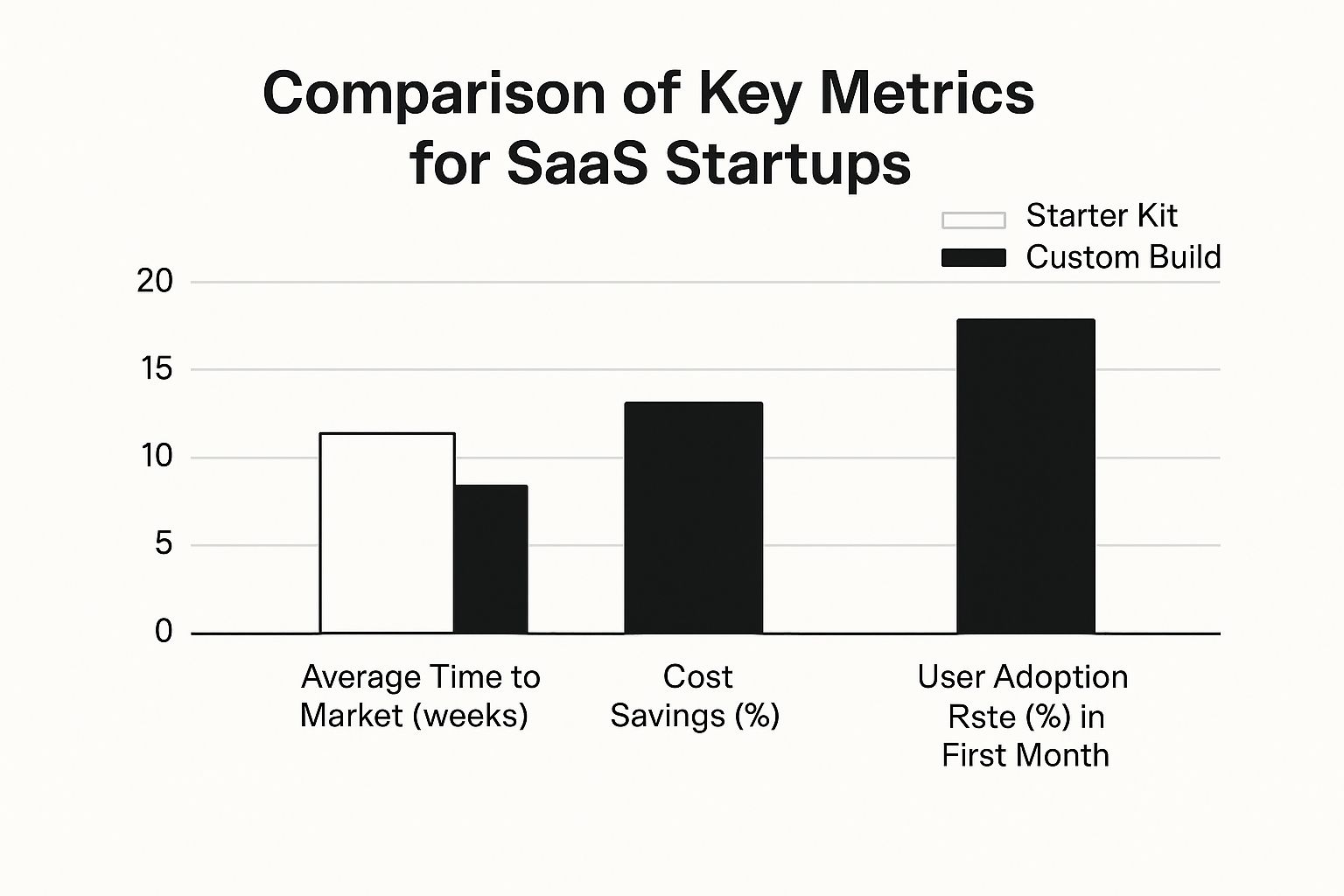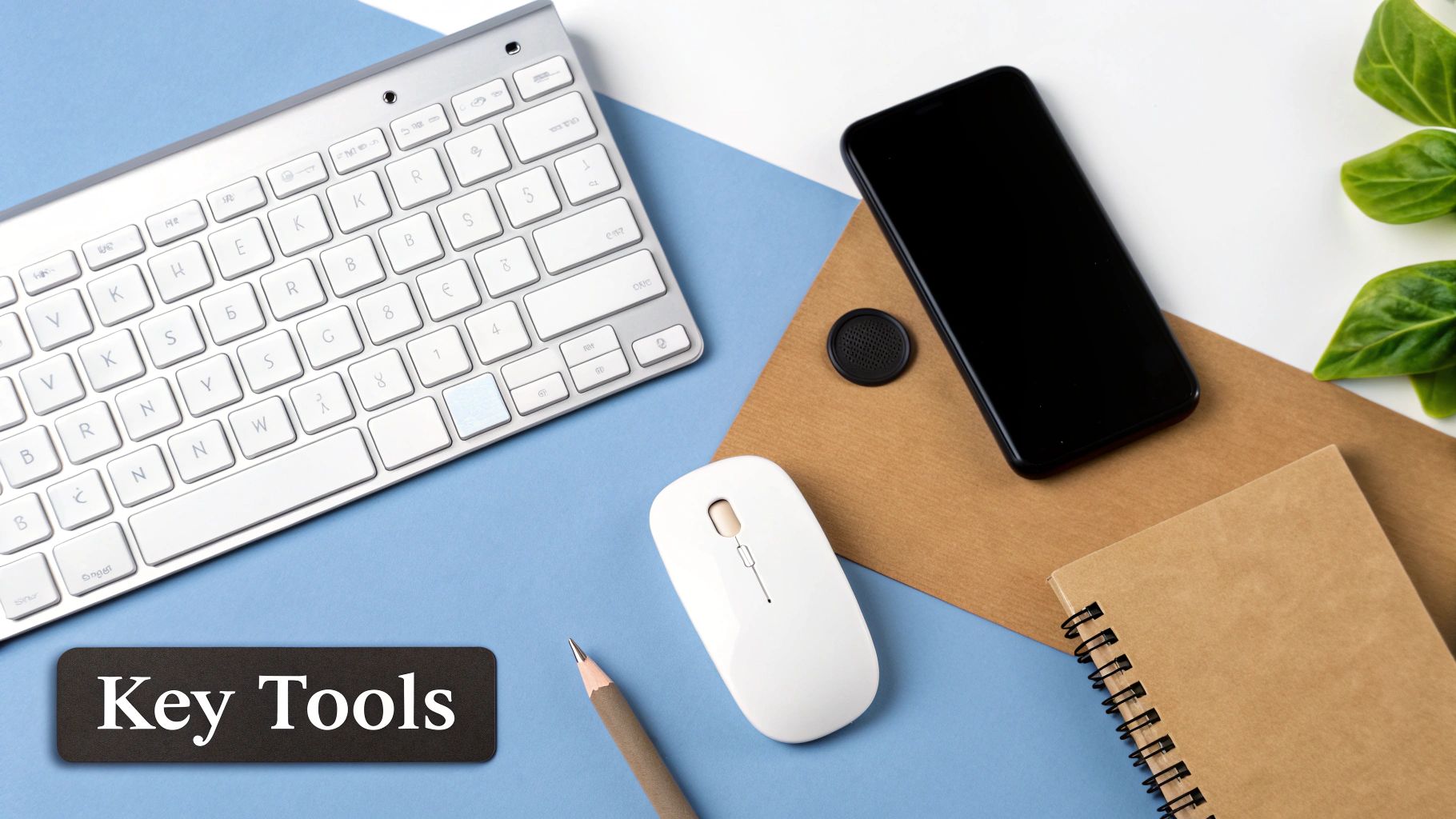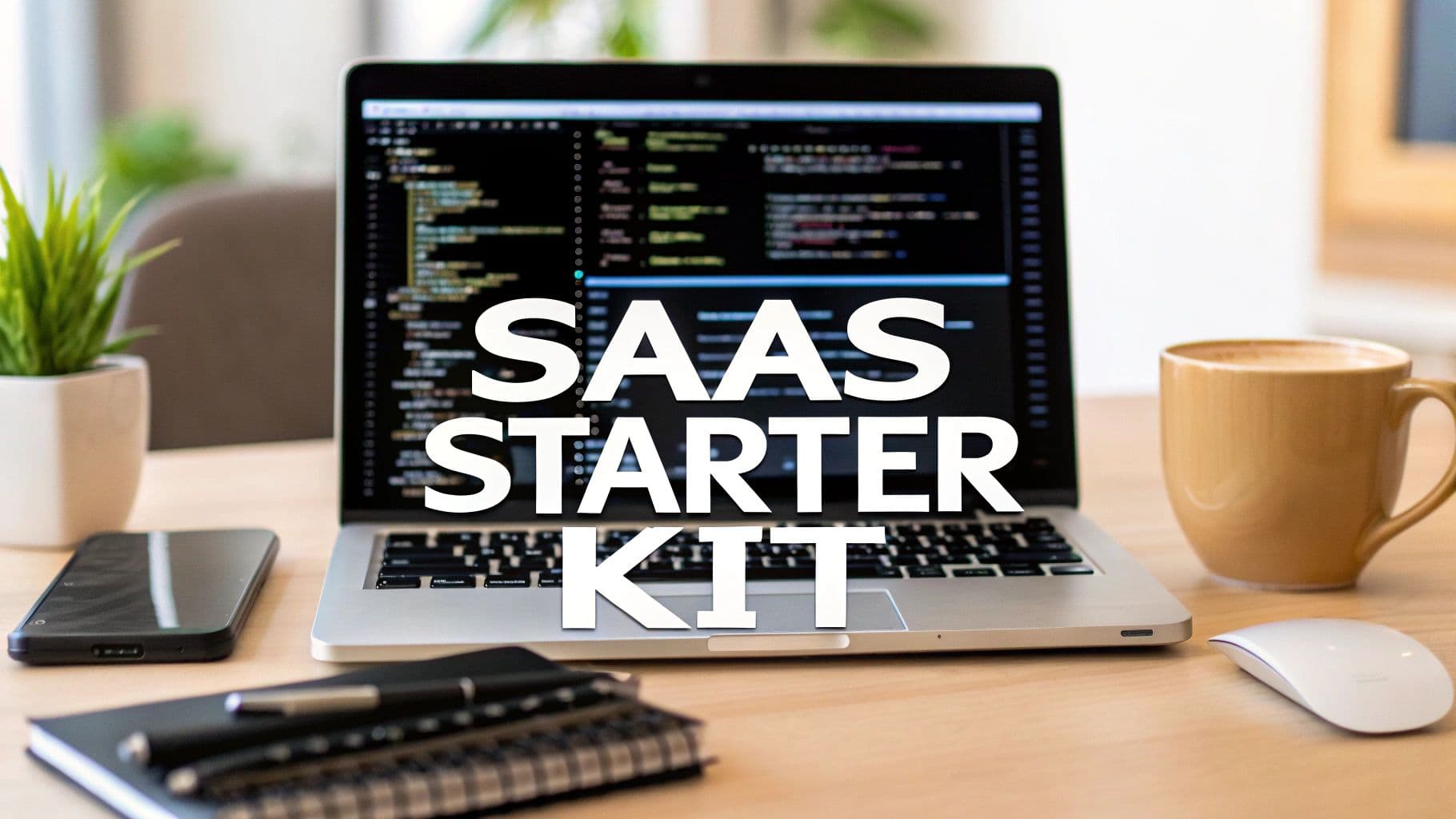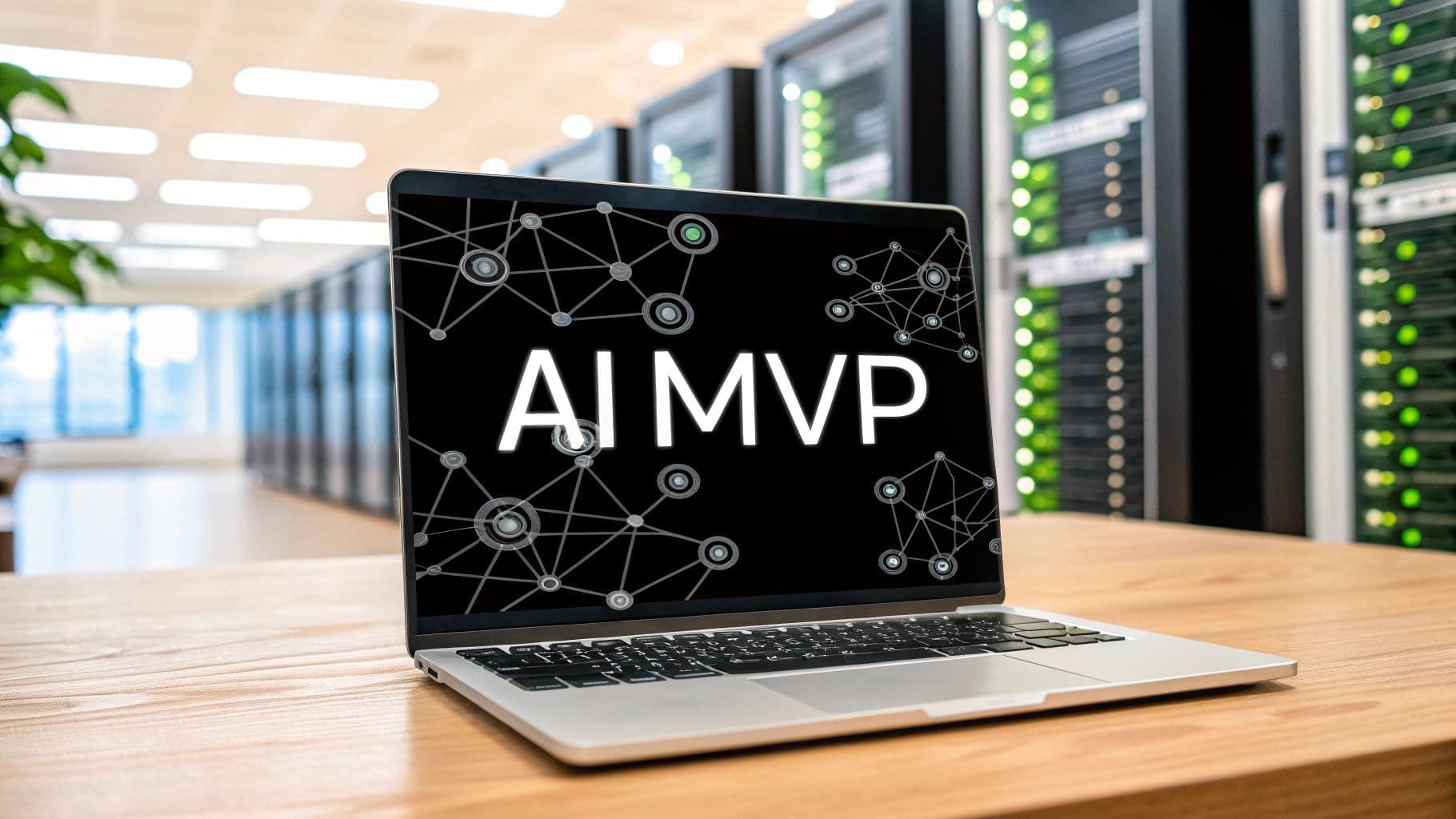saas starter kit
software business
startup tools
cloud software
saas development
SaaS Starter Kit: Your Complete Guide to Building Software
Understanding the SaaS Opportunity That's Right in Front of You
The Software-as-a-Service (SaaS) industry is experiencing rapid growth, changing how businesses operate across diverse sectors. This presents a significant opportunity for new ventures, particularly those utilizing a robust SaaS starter kit. But how can you pinpoint the perfect opportunity for your SaaS product?
One effective strategy is concentrating on niche markets. Larger, established companies often overlook the specific needs of smaller market segments, creating openings for agile startups. For instance, a comprehensive Customer Relationship Management (CRM) platform might cater to large enterprises while neglecting the unique requirements of small businesses. This gap presents a potential entry point for a more specialized SaaS solution.

Understanding customer pain points is also essential. What problems are existing solutions failing to solve? By identifying these frustrations and providing a targeted solution, you can attract customers actively seeking better options. This focused approach is far more effective than directly competing with industry giants.
However, understanding the competitive landscape remains vital. Even within a niche market, you’ll likely encounter competition. Analyzing their strengths and weaknesses enables strategic positioning of your SaaS offering. This could involve providing unique features, competitive pricing, or exceptional customer support. You might find some inspiration from these Micro SaaS Ideas.
This market analysis is directly linked to the overall SaaS market growth. The global SaaS market was valued at approximately $197 billion in 2023 and is projected to reach around $299 billion by 2025. This impressive growth is driven by factors such as increased adoption of cloud technologies and AI integration. This signifies a rapidly expanding customer base for SaaS products, creating even more opportunities for new businesses. More detailed statistics can be found here.
Validating Your SaaS Idea With a Starter Kit
Before committing significant resources, validating your SaaS idea is crucial. A SaaS starter kit can be incredibly helpful in this process. It provides the foundation for rapidly building a Minimum Viable Product (MVP). This allows you to test core features with actual users and gather crucial early feedback.
This early feedback loop allows you to iterate and refine your product based on real-world use. A SaaS starter kit empowers you to adapt and improve your offering before committing to full-scale development, reducing the risk of building a product that misses the mark.
Furthermore, a SaaS starter kit can significantly accelerate your time to market. The pre-built components and functionalities included in the kit drastically reduce development time. This gets your MVP launched faster, allowing you to gain early traction and begin collecting user data sooner.
By combining a thorough understanding of market opportunities with the practical advantages of a SaaS starter kit, you can dramatically increase your chances of SaaS success. This strategic approach helps you navigate the competitive landscape effectively and build a product that genuinely resonates with your target audience.
Building Your Foundation With the Right Starter Kit Components
A successful SaaS product needs a solid technical base. Many founders, however, spend their valuable time building functionalities that already exist. SaaS starter kits offer a solution to this problem, providing pre-built components so you can concentrate on what makes your product special. But what separates a truly robust starter kit from a basic template?
Key Components of a Robust SaaS Starter Kit
A strong SaaS starter kit goes beyond simple front-end templates. It offers crucial backend functions, enabling a quicker launch and more effective scaling. This includes features like:
-
Authentication: Secure user registration and login, including social login integrations and multi-factor authentication.
-
Payment Processing: Integration with well-known payment gateways like Stripe, handling subscriptions and managing recurring billing. This allows you to effectively monetize your SaaS product from the very beginning.
-
Database Integration: A pre-configured database setup for storing and managing user data, product information, and other essential data.
-
Analytics Dashboard: Track important metrics, such as user engagement, churn rate, and conversion rates. This data provides insights for continuous improvement and optimization.
-
Email Integration: Automated email notifications for user onboarding, password resets, and other vital communications.
These components are the foundation of any successful SaaS product. By utilizing a starter kit with these pre-built functions, you can save valuable development time and concentrate on building your core product features.
To illustrate the advantages of using a starter kit, take a look at the comparison table below. It outlines the key components included in different starter kit options and compares them to a custom build approach.
To illustrate the advantages of using a starter kit, let’s explore the core components across various levels and compare them with the more demanding route of a custom build. The table below provides a detailed comparison.
SaaS Starter Kit Components Comparison
A detailed comparison of essential technical and business components across different starter kit approaches.
| Component | Basic Kit | Professional Kit | Enterprise Kit | Custom Build |
|---|---|---|---|---|
| Authentication | Basic User/Password | Social Login & MFA | Customizable Auth Flows | Full Control & Customization |
| Payment Processing | Single Gateway Integration | Multiple Gateway Options | Advanced Subscription Management | Requires Custom Integrations |
| Database Integration | Basic Setup | Optimized Schema | Scalable Database Solution | Full Database Control |
| Analytics Dashboard | Basic Metrics | Advanced Reporting | Custom Reporting & Integrations | Requires Custom Development |
| Email Integration | Basic Notifications | Transactional Emails & Automation | Advanced Segmentation & Personalization | Requires Custom Integrations |
As you can see, starter kits offer a range of functionalities to suit different needs and budgets. While a custom build offers maximum control, it also requires significantly more time and resources.
The infographic below visually compares key metrics of SaaS startups using a starter kit versus a custom build. It shows the average time to market, cost savings, and user adoption rate for each approach.

As the infographic shows, starter kits drastically reduce time to market, resulting in higher user adoption rates and significant cost savings. This allows startups to launch quickly, validate their product, and become profitable sooner. For a deeper dive into the micro-SaaS model, read also: How to Build a Micro SaaS.
Customizing Your Starter Kit Without Over-Engineering
While a starter kit gives you a good foundation, customization is important for making your SaaS product stand out. However, it's essential to find a balance. Focus on adapting the user interface (UI) and user experience (UX) to fit your brand and target audience.
For example, customizing the color scheme, typography, and layout can greatly impact how users see your product. Also, tailoring the onboarding process to your users’ specific needs can increase user engagement and retention.
Building a SaaS product is complex, but using the right tools from the start is essential. A well-chosen SaaS starter kit streamlines development, allowing you to reach your market faster and increasing your chances of success.
Securing Investment That Actually Fuels Your Growth

The SaaS startup funding landscape is in constant flux. To secure the investment needed for scaling your business, understanding what investors seek is paramount. This requires more than a compelling idea; it demands a keen grasp of market dynamics and a clear vision for your SaaS product. A SaaS starter kit can be an invaluable asset in this process.
Demonstrating Traction and Market Opportunity
Investors prioritize traction, meaning demonstrable potential for genuine growth and market share. A SaaS starter kit enables rapid Minimum Viable Product (MVP) development and launch. This early launch facilitates the gathering of crucial user data and provides market validation, key factors in attracting investor interest.
A compelling narrative about your market opportunity is also essential. Clearly articulate the problem your SaaS product solves and the specific market need it addresses. Identify your target audience and showcase how your product uniquely addresses their pain points.
For example, if your SaaS product simplifies project management for small businesses, emphasize the challenges these businesses face and how your solution streamlines their workflows. This targeted approach resonates more effectively with investors than broad claims about market size.
Early adoption metrics and positive user feedback further strengthen your pitch. These early indicators showcase the product's genuine potential and resonance with your target audience.
The growing investment in the SaaS sector also underscores investor confidence. In 2023, SaaS startups secured 47% of all venture capital funding, a significant increase from 36% in 2019. This surge highlights the potential of the SaaS model and creates a favorable environment for seeking investment. Learn more about the latest SaaS trends.
Approaching Investors Strategically With Your SaaS Starter Kit
Different investors have different priorities. Angel investors may focus on the team and early vision, while venture capital firms often look for scalable business models and strong growth potential. Understanding these nuances is critical for tailoring your pitch and targeting the right investors.
A SaaS starter kit is a powerful tool when approaching investors. Using a starter kit to rapidly build and launch your MVP demonstrates resourcefulness and a focus on efficient development.
This efficiency appeals to investors by showcasing resource maximization and minimized time to market. The rapid development approach allows for faster iteration based on user feedback, another key factor investors value.
Structuring Deals That Support Long-Term Growth
Securing investment isn't solely about the money; it's about finding partners aligned with your vision. Negotiating deals that support your long-term goals while providing necessary resources is crucial for sustainable growth.
Clearly define your key performance indicators (KPIs) and your plan for achieving them. This transparency builds trust with investors and ensures shared expectations. A well-defined roadmap, supported by the efficient development facilitated by your SaaS starter kit, demonstrates your commitment to achieving these goals.
By combining a strong understanding of investor expectations with the practical benefits of a SaaS starter kit, you can position your SaaS venture for success. This strategic approach helps secure investment that fuels growth and enables you to build a sustainable and thriving business. It's about presenting not just a product, but a vision for the future.
Launching Smart With Your Minimum Viable Product Strategy
Launching a successful Software as a Service (SaaS) product demands a careful balance. You need to ship quickly, but also ensure your product resonates with users. This requires strategic planning of your Minimum Viable Product (MVP). A SaaS starter kit can be a valuable asset during this process.
Identifying Your Core Feature Set
Don't try to build every feature at once. Focus on the core functionalities that address your target audience's most critical pain points. A SaaS starter kit helps you rapidly implement essential features like authentication and payments. This allows you to concentrate on your unique value proposition.
For example, imagine you’re building project management software. Your MVP might include task creation, assignment, and basic progress tracking. More complex features, like Gantt charts or resource allocation, can be added later. This focused approach enables faster validation of core functionalities and rapid feedback from real users.
Validating Assumptions and Iterating Based on Feedback
Creating an MVP is not a one-time event. It’s about testing assumptions with real users and iterating based on their feedback. A SaaS starter kit provides the flexibility to quickly adapt your MVP as you gain user insights.
This iterative process lets you refine your product based on actual usage, not just theory. By quickly adapting to user feedback, you improve the likelihood of building a product that truly meets market needs.
Measuring Product-Market Fit: Beyond Vanity Metrics
It's tempting to focus on vanity metrics like website traffic or social media followers. True product-market fit, however, is measured by user engagement, retention, and customer lifetime value. A well-planned MVP, coupled with the rapid development capabilities of a SaaS starter kit, helps you gather these crucial metrics early on.
Focusing on meaningful metrics guides your product roadmap. This ensures you're building a product people actually want to use, not just one that looks good on paper.
Gathering User Insights That Drive Your Roadmap
Effective user feedback is more than just bug reports. It involves understanding how users interact with your product, their frustrations, and their unmet needs. Implement systems for gathering both quantitative and qualitative data. Tools like user surveys, in-app feedback forms, and user interviews offer invaluable insights.
Combine these insights with the rapid iteration enabled by a SaaS starter kit to continuously improve your product and stay ahead of the competition. Your SaaS starter kit helps you quickly implement changes based on feedback, creating a dynamic development cycle.
Maintaining Quality While Moving at Startup Speed
Speed is crucial in SaaS, but not at the cost of quality. A SaaS starter kit offers a solid technical foundation for your MVP. This allows for rapid development without sacrificing code quality or security.
For example, choosing a SaaS starter kit with pre-built authentication and secure payment processing maintains high security standards from day one. AnotherWrapper is an excellent example of this balance. Its comprehensive features and focus on rapid development allow you to quickly launch sophisticated AI-powered SaaS applications. It also helps you adhere to best practices in security and code structure, building a sustainable and scalable product.
Launching with an MVP isn’t about building an incomplete product. It's about strategically prioritizing core features and iterating based on user feedback. Learn more about how to Build a Minimum Viable Product (MVP) for Success in B2B Markets. By using a SaaS starter kit, you can navigate this process effectively and build a product that truly resonates with your target audience. Remember, building a successful SaaS product is a marathon, not a sprint.
Growing Your SaaS Business Beyond the Initial Launch
Building a successful SaaS business with a SaaS starter kit isn't just about the initial launch. It's about establishing sustainable growth and transitioning from a promising startup to a thriving, scalable business. This involves careful planning in several key areas, from customer acquisition and retention to team building and infrastructure.
Optimizing Customer Acquisition and Reducing Churn
Acquiring customers is essential for any SaaS business, but retaining them is equally vital. Effective onboarding plays a critical role in minimizing churn. A smooth, intuitive onboarding experience quickly familiarizes users with your product's value, making them much more likely to stay engaged.
Interactive tutorials, personalized welcome emails, and readily available support resources can significantly enhance user onboarding and improve long-term retention. This targeted approach empowers users to become proficient with your SaaS product, maximizing its value and reducing the risk of churn.
Additionally, focus on establishing reliable recurring revenue streams. While the subscription model inherent to SaaS provides predictable income, maximizing its potential requires optimizing pricing strategies and offering outstanding customer service. This builds customer loyalty and encourages long-term subscriptions. You might be interested in this resource: How to master SaaS Revenue Models.
Scaling Your Infrastructure and Team for Growth
As your SaaS business expands, so too will your technical requirements. Efficiently managing your technical infrastructure is crucial for maintaining optimal performance and reliability. When first launching your SaaS product, starting with a Minimum Viable Product (MVP) is a key strategy; this article provides a helpful guide on building one.
This might involve scaling your servers, optimizing database performance, and implementing robust monitoring systems. Planning for scalability from the outset, by choosing the right SaaS starter kit, can prevent expensive rebuilds later on.
Building the right team is also essential. Recruit individuals who not only possess the necessary technical skills but also align with your company culture. A cohesive and motivated team is fundamental for long-term success in the SaaS industry.
The global SaaS market is projected to reach approximately $1,251.35 billion by 2034, growing significantly from $408.21 billion in previous years. This impressive growth is driven by the increasing demand for cloud-based solutions. More detailed statistics can be found here. This expanding market presents substantial opportunities, but capitalizing on them demands a scalable and adaptable business model.
Strategic Partnerships and Pricing Optimization
Strategic partnerships can significantly accelerate your growth trajectory. Collaborating with complementary businesses extends your reach and introduces your SaaS product to a broader audience. Identifying potential partners who align with your target market is a potent growth strategy.
Moreover, continuous pricing optimization is essential. Analyze market trends, competitor pricing, and your own customer acquisition costs to determine the most effective pricing structure. This might entail offering various subscription tiers, usage-based pricing, or discounts for annual subscriptions.
To help visualize key metrics and their benchmarks at different stages, consider the following table:
SaaS Growth Metrics and Benchmarks: Key performance indicators and industry benchmarks for measuring SaaS business health and growth trajectory
| Metric | Early Stage | Growth Stage | Scale Stage | Industry Benchmark |
|---|---|---|---|---|
| Customer Churn Rate | 5-7% | 3-5% | <1% | <5% |
| Monthly Recurring Revenue (MRR) Growth Rate | 15-20% | 10-15% | 5-10% | >10% |
| Customer Lifetime Value (CLTV) | $500 - $2,000 | $2,000 - $10,000 | >$10,000 | Varies based on industry |
| Customer Acquisition Cost (CAC) | $100 - $500 | $500 - $1,500 | $1,500 - $5,000 | < 1/3 of CLTV |
This table provides a general overview of key SaaS metrics and their typical ranges across various stages of business growth. It's essential to adapt these benchmarks to your specific industry and business model.

Growing your SaaS business beyond the initial launch requires a multifaceted approach. By focusing on customer acquisition and retention, scaling infrastructure and your team strategically, forming beneficial partnerships, and continually optimizing your pricing, you can cultivate a successful and sustainable SaaS business that thrives in this expanding market.
Avoiding The Mistakes That Derail SaaS Startups
Even well-funded SaaS ventures with talented teams can stumble into common pitfalls. These mistakes can deplete resources and stall momentum. They often range from architectural limitations that hinder scaling to pricing strategies that stifle sustainable growth. Understanding these potential hazards, especially when starting with a SaaS starter kit, is essential for building a successful SaaS business.
Architectural Decisions That Limit Scalability
One of the most frequent technical oversights is choosing an architecture that doesn't scale. Initially, a simple setup might be sufficient. But as your user base expands, a poorly designed architecture can create performance bottlenecks and escalating costs. For example, depending solely on a single database server without planning for future database sharding can severely restrict your growth as data volume increases. This can lead to slowdowns and even outages, negatively impacting user experience and your revenue.
Another architectural pitfall is overlooking API design. A well-designed API is crucial for integrating with other services and enabling future expansion. A poorly planned API can lead to technical debt, making it difficult to add new features or integrate with other platforms. This can significantly limit your SaaS product’s growth potential.
Pricing Strategies That Prevent Sustainable Growth
Pricing is a delicate balancing act. Setting prices too low can hurt profitability. Pricing too high can deter potential customers. One common mistake is not differentiating pricing tiers effectively. Offering distinct tiers with varied features and usage limits caters to different customer segments and optimizes revenue.
Another pricing mistake is neglecting to research competitor pricing. Understanding your pricing relative to the competition is key to attracting customers. This requires thorough market analysis to understand customer expectations and price sensitivity. Ignoring this can result in a loss of market share.
Recognizing Warning Signs And Implementing Preventative Measures
Early problem identification is essential. Monitoring key metrics such as churn rate and customer acquisition cost can reveal underlying problems. A rising churn rate, for instance, could indicate issues with product usability or customer satisfaction. Addressing these issues proactively can prevent customer loss and maintain healthy growth. For long-term SaaS success, effective technical SEO is essential. This article explains the importance of technical SEO for SaaS.
Implementing robust monitoring and alert systems is crucial for identifying and resolving technical issues before they affect users. This includes monitoring server performance, database health, and API response times. Proactive monitoring allows you to quickly address problems, preventing downtime and maintaining user trust.
Building Resilience Into Your SaaS Business Model
Navigating software development requires resilience. Unexpected bugs, market shifts, and evolving customer needs can all impact your progress. Building flexibility into your development process enables you to adapt quickly and efficiently.
This means using an iterative development process and a Minimum Viable Product (MVP) to test assumptions and gather user feedback. Being adaptable in your product roadmap based on this feedback is essential for building a product that truly meets market needs. This agility is vital for success in the competitive SaaS market.
Maintaining team morale is also critical. A positive work environment fosters creativity and productivity. This is particularly important during challenging times. Open communication, clear goals, and recognizing individual contributions are key components of a thriving team culture.
Making course corrections without losing investor confidence or customer trust requires transparency and clear communication. Keep investors updated on challenges and your solutions. Communicate openly with customers about any issues and the steps you’re taking to resolve them. This builds trust and strengthens relationships, even during difficult times.
Start building your SaaS today with AnotherWrapper, a comprehensive AI starter kit that allows you to launch AI-powered micro SaaS projects quickly and efficiently.
Fekri




